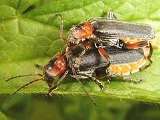
Cantharis fusca
Encyclopedia
Cantharis fusca is a species of soldier beetle
.
C. fusca reaches a length of 10–15 mm (0.393700787401575–0.590551181102362 ). Except for parts of the head and thorax, which are red or orange, this species is completely black. The body is flat and long, with a weak exoskeleton
. These beetles have long feathery antennae, and comparatively long legs.
This species is common in large parts of Europe, and lives in bushes, edges of forests, and meadows. They hunt for small insects.
The larvae have black hairs, and also eat small insects. They are very cold-resistant, and can be seen crawling on the snow in winter.
Soldier beetle
The soldier beetles, Cantharidae, are relatively soft-bodied, straight-sided beetles, related to the Lampyridae or firefly family, but being unable to produce light. They are cosmopolitan in distribution. One common British species is bright red, reminding people of the red coats of soldiers, hence...
.
C. fusca reaches a length of 10–15 mm (0.393700787401575–0.590551181102362 ). Except for parts of the head and thorax, which are red or orange, this species is completely black. The body is flat and long, with a weak exoskeleton
Exoskeleton
An exoskeleton is the external skeleton that supports and protects an animal's body, in contrast to the internal skeleton of, for example, a human. In popular usage, some of the larger kinds of exoskeletons are known as "shells". Examples of exoskeleton animals include insects such as grasshoppers...
. These beetles have long feathery antennae, and comparatively long legs.
This species is common in large parts of Europe, and lives in bushes, edges of forests, and meadows. They hunt for small insects.
The larvae have black hairs, and also eat small insects. They are very cold-resistant, and can be seen crawling on the snow in winter.

